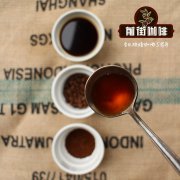Why the coffee species in Ethiopia are all native species the historical reason for the word "native species"

When we talk about Ethiopian coffee, some people use words such as jasmine, rose fruit and magnolia to describe the smell of flowers, but have you ever wondered why these specific varieties with floral flavor are often summed up as "native species"?
In the early days of the third wave of coffee, native species were often used to describe Ethiopian coffee, but this is not very accurate. Because people do not fully understand these varieties at all, many local producers are deprived of the opportunity to know more varieties and earn higher income, and bean bakers are unable to distinguish the differences between these varieties. Consumers also do not have the opportunity to taste new varieties and new flavors, because it is not clear what varieties to choose from.
But changing this situation is easy to say, but difficult to do. Let's take a closer look at the true meaning of native species and the difficulties encountered in improving the transparency of their information.
The true meaning of native species
The word "native species" refers to the ancient varieties of plants that were originally planted to be eaten, while some people define a variety that takes more than 100 years to be called a native species, while others say 50 years. Then some people define varieties that existed before 1945 as native species, about the time when hybrids began to emerge, or 1951, when hybrids became more widespread.
In the coffee industry, you will find that the term native species applies to varieties introduced in South America and Asia more than a hundred years ago, as well as to many coffee varieties in Africa, especially those from Ethiopia.
Getu Bekele, East Africa supply chain manager at Counter Culture Coffee in the United States, who works to build an index of Ethiopian coffee varieties, says that in Ethiopia, the emergence of the word native species occurred after the start of the boutique coffee movement. At that time, buyers of boutique coffee, which could not tell the difference between Tibica and bourbon, would collectively refer to all these unknown varieties as native species.
But Getu said Ethiopian coffee producers use different names to distinguish different coffee plants. instead of globally recognized scientific names, they usually use local words, or borrow some of the characteristics of local coffee trees to refer to a variety of coffee trees.
Medina Hussein, export department manager at coffee exporter DW Coffee and a supplier of Ethiopian coffee, said boutique coffee buyers would distinguish Ethiopian coffee by region, altitude and cup score, rather than by variety.
In a broad sense, Ethiopian coffee varieties can be divided into two categories: JARC varieties and regional local varieties.
The JARC variety is paired by the Jima Agricultural Research Center, an institution of the Ethiopian Federal Agricultural Research Center, which is set up to study pest resistance and increase yield. There are about 40 varieties in it. Regional local varieties are wild varieties grown in the wild in Ethiopia. Getu says there may be more than 10, 000 of these wild species.
This means that when consumers buy a bag of Ethiopian coffee and see the bean bag marked with native species, the coffee may be a combination of more than 10,000 varieties.
Advantages of using specific variety names
What if the buyer does not want to use the general name of the original species, but asks for a variety with a specific name? There is a view that this will help to communicate varieties with a common name in Ethiopia and help us understand the order in which varieties appear.
"if you look at the map of Ethiopian coffee varieties made by Counter Cultrue's Kiburi, Sinde, Bedessa and Ywan, all the regional local varieties from the west and southwest of Ethiopia have different characteristics, flavors and tastes," Getu said.
"if you tell a farmer to produce only western and southwestern local varieties, he will mix these different varieties to produce a mixed flavor. "
So identifying varieties and selling specific varieties can more accurately meet the needs of buyers and purchase coffee according to their desired flavor characteristics.
Getu asked producers in the Guji region to start distinguishing production batches. "when the harvest was over that day, we found that a local variety, Kurume, was an amazing variety that had a way to improve the overall flavor quality of coffee produced in the region," he said. "
He hopes that by identifying specific varieties and selling them, small farmers can earn better with their crops.
Using variety names may help farmers in other ways. When you grow coffee on a large area of farmland, if you only know the original species, you may find that these varieties are not resistant to diseases and insect pests only after you have invested heavily in planting varieties. If a variety name is used, farmers can estimate the risk when choosing a variety.
Problems that may be caused by abandoning the name of the original species
The word native species may be too general, but there are still some advantages to using it.
First of all, naming each variety one by one is also a problem, because the same variety is not often found in different areas. Getu explained: "if you grow a variety in Haararge and grow the same variety in Yega Sheffield, you can't get the same planting potential and the same flavor quality. "
This means that varieties grown in different areas have different characteristics, so it may be confusing to call the variety by the same name.
If buyers take the time to familiarize themselves with all the varieties in Guji, they may find that the variety information of Guji is not helpful when looking at the completely different varieties in Haararge, which makes it very difficult for a single buyer to learn about Ethiopian coffee varieties.
Another challenge is that producers are used to mixing varieties at harvest and simply refer to the harvested coffee as the original species to sell. Therefore, if you only want buyers of regional local varieties, it may be difficult to buy the varieties they want.
Medina says that if a buyer asks him to purchase regional varieties from a particular region, he may only be able to provide 50 or 100 bags, and there may be no more. He also needs potential buyers to inform him of such needs before the harvest to ensure that the varieties of the harvest will not be mixed together to meet the needs of the buyers.
This is also related to the fact that many farmers in Ethiopia are small farmers who grow coffee as a cash crop, choosing varieties based on disease resistance and high yield, while flavor is a secondary consideration.
MOPLACO's boss, Heleanna Georgalis, who is also an exporter of raw beans, says that if the baker wants to work with farmers to experiment with specific varieties of coffee, both sides will be bothered. A small farmer with only 0.01ha of land will not want to sell you 10kg of raw beans. And bean bakers will not be willing to pay a high price of $200 per kilogram in order to hire farmers to plant a variety.
So while it may seem illogical to group thousands of varieties together in one general term, it makes sense in the context of Ethiopian infrastructure.
JARC has been working to record the genes of different coffee varieties, and some buyers are working together to develop a common language for communicating these varieties.
But there is still a long way to go to record each variety and reach a consensus on the reference materials of each variety. "it will take a long time to achieve full variety transparency in Ethiopia," Heleanna said.
Getu Bekele sees a bright future in Ethiopian Coffee. "Ten years from now, we are all looking forward to high-quality and delicious coffee from all over Ethiopia. "
If consumers ask stores for more details about Ethiopian coffee varieties, bean bakers may turn to ask raw bean merchants from which varieties of these native species are mixed. On the other hand, the transparency of information can spread throughout the supply chain, benefiting all roles in the supply chain from source to end.
In this paper, James Harper. Written, translated from Perfect Daily Grind
Important Notice :
前街咖啡 FrontStreet Coffee has moved to new addredd:
FrontStreet Coffee Address: 315,Donghua East Road,GuangZhou
Tel:020 38364473
- Prev

Is Rabirika a boutique coffee? why has it not been promoted in the wild?
The most common varieties in the coffee industry are Arabica and Robusta, but there is also Laiberia coffee that is often forgotten by the public, and this variety is often recognized by the boutique coffee industry as "bitter, metallic and woody" coffee, making it even less valued. Recently, a team of several Malaysian and German professionals questioned this claim, believing that it was appropriate
- Next

What's the difference between large batches, micro batches and nano batches? the smaller the batch, the better the quality?
Quality, traceability, direct trade, reasonable price, unique flavor and good handling are the excellent properties of single coffee and micro-batch coffee. But if you put aside these definitions, do you know what "single origin" means? What is the difference between a single manor, micro-batch or even nano-batch? And how can producers make sure that micro-batches are not mixed with other batches of coffee?
Related
- Detailed explanation of Jadeite planting Land in Panamanian Jadeite Manor introduction to the grading system of Jadeite competitive bidding, Red bid, Green bid and Rose Summer
- Story of Coffee planting in Brenka region of Costa Rica Stonehenge Manor anaerobic heavy honey treatment of flavor mouth
- What's on the barrel of Blue Mountain Coffee beans?
- Can American coffee also pull flowers? How to use hot American style to pull out a good-looking pattern?
- Can you make a cold extract with coffee beans? What is the right proportion for cold-extracted coffee formula?
- Indonesian PWN Gold Mandrine Coffee Origin Features Flavor How to Chong? Mandolin coffee is American.
- A brief introduction to the flavor characteristics of Brazilian yellow bourbon coffee beans
- What is the effect of different water quality on the flavor of cold-extracted coffee? What kind of water is best for brewing coffee?
- Why do you think of Rose Summer whenever you mention Panamanian coffee?
- Introduction to the characteristics of authentic blue mountain coffee bean producing areas? What is the CIB Coffee Authority in Jamaica?

